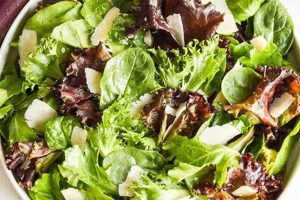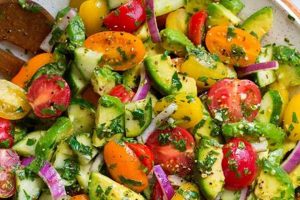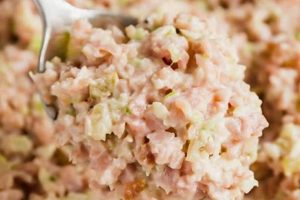A dish featuring cured herring as its central ingredient, typically combined with diced vegetables like potatoes, onions, and beets, bound with a creamy dressing often based on mayonnaise, sour cream, or yogurt. Variations may include apples, pickles, or hard-boiled eggs, offering a wide range of flavor profiles from tangy to sweet. For instance, a classic Scandinavian preparation might involve pickled herring, potatoes, and sour cream, while a German version could feature Bismarck herring with apples and onions.
Providing a substantial source of protein and omega-3 fatty acids, this culinary creation offers nutritional value alongside its diverse flavors. Its historical roots can be traced to various Northern European cultures, where preserved fish played a vital role in diets, especially during colder months. Different regional interpretations reflect unique cultural preferences and available ingredients, demonstrating the adaptability of this simple yet satisfying dish.
This exploration delves into the nuances of preparing this dish, covering topics ranging from ingredient selection and preparation techniques to diverse regional variations and modern adaptations. It will also examine the nutritional benefits of herring and the historical context that shaped its culinary significance.
Tips for Preparing Herring Salad
Achieving optimal flavor and texture requires careful consideration of several key elements. The following tips offer guidance for creating a successful and enjoyable dish.
Tip 1: Herring Selection: Opt for high-quality herring fillets, either pickled, salted, or smoked, depending on the desired flavor profile. Matjes herring, with its mild and slightly salty taste, is a popular choice.
Tip 2: Balancing Flavors: The interplay of sweet, sour, and savory components is crucial. Balance the richness of the herring with acidic elements like vinegar or pickles, and incorporate sweetness through apples or beets.
Tip 3: Texture Considerations: Dice ingredients uniformly for a pleasing consistency. Avoid overmixing, which can result in a mushy texture. Retain some bite in the vegetables.
Tip 4: Dressing Choices: Mayonnaise, sour cream, and yogurt serve as excellent bases for the dressing. Enhance the flavor with Dijon mustard, horseradish, or fresh herbs like dill or chives.
Tip 5: Chilling Time: Allow the salad to chill for at least an hour before serving. This allows the flavors to meld and the textures to firm up.
Tip 6: Garnishing and Presentation: Elevate the visual appeal with fresh herbs, hard-boiled egg slices, or a sprinkle of paprika. Serve chilled on crispbread, dark rye bread, or as a standalone dish.
Tip 7: Ingredient Sourcing: Utilize fresh, seasonal ingredients whenever possible. The quality of the ingredients directly impacts the final outcome.
By adhering to these guidelines, one can create a herring salad that is both flavorful and visually appealing, highlighting the unique characteristics of this versatile dish.
These practical tips provide a foundation for creating a delicious and authentic herring salad. The following section concludes this exploration with a summary of key takeaways and suggestions for further culinary experimentation.
1. Herring Type
Herring type significantly influences the final character of a herring salad. Different curing methods impart distinct flavors and textures, requiring careful consideration during recipe development. Salted herring, for example, offers a pronounced salty taste and firm texture, often necessitating soaking or rinsing before incorporation. Pickled herring, conversely, presents a softer texture and a spectrum of flavors depending on the pickling brine, ranging from sweet and sour to dill-infused. Smoked herring contributes a smoky depth and a flaky texture. Understanding these distinctions allows for informed decisions regarding complementary ingredients and dressing choices.
A salad featuring heavily salted herring benefits from the addition of milder elements like boiled potatoes and apples to balance the saltiness. A lighter vinaigrette dressing avoids exacerbating the saltiness. Pickled herring, particularly those pickled in vinegar, harmonizes with sweeter and richer components, such as beets and sour cream dressings. Smoked herring, with its robust flavor profile, often pairs well with onions, capers, and mustard-based dressings. The interplay of these elements creates a balanced and nuanced flavor experience. A Matjes herring, lightly cured in a mild brine, provides a delicate flavor that complements lighter dressings and fresh herbs.
Selecting the appropriate herring type is paramount to a successful herring salad. Careful consideration of the herring’s flavor profile and texture ensures a harmonious balance of ingredients. This understanding allows for greater culinary control and the creation of a dish tailored to specific taste preferences. Ignoring these nuances can result in a dish where the herring either overwhelms or underwhelms the other components. Through informed selection and thoughtful pairing, herring salad becomes a showcase for the versatility and culinary potential of this often-underappreciated fish.
2. Ingredient Preparation
Ingredient preparation significantly impacts the final quality of herring salad. Careful attention to detail elevates this seemingly simple dish, transforming individual components into a cohesive and flavorful whole. Improper preparation can result in textural inconsistencies and unbalanced flavors, diminishing the overall culinary experience. For instance, neglecting to soak salted herring adequately can lead to an overwhelmingly salty salad, while unevenly diced vegetables create an unappealing visual and textural disparity.
Consider potatoes, a common ingredient in herring salad. Boiling potatoes until tender yet firm ensures they maintain their shape when mixed with other ingredients. Overcooked potatoes become mushy, contributing to an undesirable texture. Similarly, onions benefit from finely dicing, mitigating their pungent bite and distributing their flavor evenly throughout the salad. Apples, when incorporated, should be peeled and diced to prevent browning and ensure a consistent bite. These preparatory steps, while seemingly minor, contribute significantly to the overall success of the dish. Even the seemingly simple act of draining pickled herring thoroughly prevents excess brine from diluting the dressing and impacting the final flavor balance.
Precise ingredient preparation ensures optimal flavor development and textural harmony in herring salad. The interplay of textures, from the tender potatoes to the crisp onions and the soft herring, creates a more satisfying sensory experience. Attention to these details distinguishes a thoughtfully prepared herring salad from a hastily assembled one. Understanding the impact of ingredient preparation empowers culinary control, allowing for the creation of a balanced and nuanced dish that highlights the inherent qualities of each component.
3. Dressing Selection
Dressing selection plays a crucial role in defining the overall flavor profile of a herring salad recipe. The dressing not only binds the ingredients together but also contributes significantly to the balance of sweet, sour, salty, and creamy elements. A well-chosen dressing elevates the dish, transforming individual components into a harmonious whole. Improper dressing selection, conversely, can overwhelm the delicate flavors of the herring and other ingredients, resulting in an unbalanced and less satisfying culinary experience.
- Creamy Dressings
Creamy dressings, often based on mayonnaise, sour cream, or yogurt, provide a rich and tangy counterpoint to the saltiness of the herring. Variations incorporating dill, chives, or horseradish further enhance the complexity of the flavor profile. For example, a dill-infused sour cream dressing complements the delicate flavor of Matjes herring, while a horseradish-spiked mayonnaise provides a robust accompaniment to smoked herring. The richness of creamy dressings also contributes to a luxurious mouthfeel, coating the other ingredients and creating a cohesive texture.
- Vinaigrettes
Vinaigrettes offer a lighter and brighter alternative to creamy dressings. A simple vinaigrette composed of oil, vinegar, and herbs provides a refreshing contrast to the richness of the herring, particularly when using oilier varieties. The acidity of the vinegar cuts through the fattiness of the fish, creating a balanced flavor profile. A mustard vinaigrette adds a touch of piquancy, while a lemon vinaigrette offers a citrusy brightness. Vinaigrettes are particularly well-suited to herring salads featuring pickled or marinated herring, where the acidity of the dressing complements the existing tanginess.
- Regional Variations
Regional variations in dressing selection often reflect local culinary traditions and ingredient availability. Scandinavian herring salads frequently feature dressings based on sour cream or yogurt, sometimes incorporating dill or mustard. German variations might include dressings made with mayonnaise and apples, contributing a touch of sweetness. Russian recipes may use a dressing incorporating sunflower oil and vinegar, offering a lighter and more acidic counterpoint to the herring. These regional variations demonstrate the adaptability of herring salad and its capacity to incorporate diverse flavor profiles.
- Balancing Flavors
The primary function of the dressing is to harmonize the various flavors present in the herring salad. The saltiness of the herring, the sweetness of any added fruits or vegetables, the acidity of pickles or vinegar, and the richness of the dressing itself must be carefully balanced to create a cohesive and enjoyable dish. A dressing that is too rich can overpower the other flavors, while a dressing that is too acidic can make the salad unpleasantly tart. A well-balanced dressing complements the herring and other ingredients, allowing each element to shine without overpowering the others. This balance is crucial for a successful and satisfying herring salad experience.
The considered selection of a dressing is essential for achieving a harmonious balance of flavors and textures in a herring salad recipe. Whether opting for a creamy, tangy, or light and bright dressing, understanding the interplay of flavors and the specific characteristics of the chosen herring variety is paramount. The dressing should not only complement the herring but also bind the other ingredients together, creating a unified and satisfying culinary experience. Regional variations offer further inspiration and demonstrate the versatility of this classic dish, allowing for a range of culinary expressions.
4. Flavor Balance
Flavor balance constitutes a critical element in a successful herring salad recipe. The inherent saltiness of herring necessitates careful consideration of other ingredients and their respective flavor profiles. A harmonious blend of contrasting yet complementary tastes distinguishes a well-executed herring salad from one that is overly salty, sweet, or sour. This balance hinges on the interplay of salt, sweet, sour, and umami elements. The specific ingredients chosen and their relative proportions dictate the final flavor profile.
Consider the interplay of pickled herring, a common component in many variations. The briny acidity of pickled herring necessitates balancing sweetness, often achieved through the incorporation of diced apples, beets, or even a touch of sugar in the dressing. The sharpness of raw onions provides a pungent counterpoint to the richness of the herring, while potatoes offer a neutral, starchy base that absorbs and distributes flavors. A creamy dressing based on mayonnaise or sour cream tempers the acidity and adds a textural element, further contributing to the overall balance. Omitting a balancing element, such as the sweetness, can result in a dish dominated by the saltiness of the herring and the acidity of the pickling brine.
Achieving flavor balance requires a nuanced understanding of ingredient interactions and their impact on the final product. A successful herring salad recipe does not merely combine ingredients; it orchestrates them in a manner that allows each element to contribute to a cohesive and enjoyable sensory experience. Careful consideration of the relative proportions of each ingredient and the overall interplay of contrasting flavors ensures a balanced and satisfying dish. Failure to achieve this balance often results in a dish where one or two flavors dominate, diminishing the complexity and enjoyment of the herring salad.
5. Chilling Time
Chilling time plays a crucial role in the development of flavor and texture in herring salad. Allowing the salad to rest in a refrigerated environment for a period of time, typically one to two hours, but ideally longer, facilitates several key transformations that contribute significantly to the overall quality of the dish. This chilling period is not merely a matter of serving temperature; it is an integral step in the recipe, impacting both the sensory experience and the food safety aspects of the final product.
During chilling, the flavors of the various componentsthe herring, vegetables, dressing, and aromaticsmeld and harmonize. The initially distinct tastes begin to integrate, creating a more complex and nuanced flavor profile. For example, the sharpness of raw onions mellows, while the flavors of the dressing permeate the other ingredients. This melding of flavors is particularly important in herring salads that incorporate strongly flavored components, such as pickled herring or pungent onions, as it allows for a more balanced and less jarring taste experience. Furthermore, the chilling process allows the textures of the ingredients to settle and firm up. Potatoes, in particular, benefit from this chilling period, as their starches set, leading to a more desirable texture. The cooling temperature also solidifies the dressing, contributing to a more cohesive and less watery consistency.
From a food safety perspective, chilling inhibits bacterial growth, a crucial consideration when working with ingredients like mayonnaise or sour cream. Maintaining a consistently low temperature minimizes the risk of spoilage and ensures the safe consumption of the salad, especially when prepared in advance. The practical significance of understanding the importance of chilling time lies in the ability to optimize both the flavor and safety of herring salad. A properly chilled salad offers a superior sensory experiencea more balanced and nuanced flavor profile, a more desirable textureand reduces the risk of foodborne illness. Therefore, chilling time should not be viewed as an optional step but as a fundamental element of a successful herring salad recipe.
6. Serving Suggestions
Serving suggestions constitute an integral aspect of any herring salad recipe, impacting not only presentation but also the overall dining experience. Consideration of complementary accompaniments and appropriate serving vessels enhances the enjoyment of this versatile dish. Serving suggestions should aim to complement the flavor profile of the specific herring salad preparation, emphasizing both visual appeal and practicality.
- Bread and Crackers
Serving herring salad with an assortment of breads and crackers provides textural contrast and enhances the overall culinary experience. Dark rye bread, pumpernickel, or crispbread offer robust flavors that complement the richness of the herring, while lighter options like white bread or crackers provide a neutral base. The choice of bread or cracker should consider the specific flavor profile of the salad. For example, a strongly flavored rye bread might pair well with a simple herring salad featuring pickled herring and potatoes, while a delicate cracker might accompany a more complex salad with smoked herring and a creamy dressing.
- Garnishes
Garnishes contribute both visual appeal and nuanced flavor enhancements. Fresh dill, chives, or parsley provide a vibrant pop of color and a herbaceous aroma, while thinly sliced red onion adds a touch of sharpness. Hard-boiled egg slices offer a creamy texture and visual contrast. A sprinkle of paprika or a dusting of freshly ground black pepper adds a subtle warmth. The choice of garnish should complement the existing flavors in the salad. For instance, a dill garnish enhances the brightness of a salad featuring pickled herring, while a sprinkle of paprika complements the smoky notes of a smoked herring salad.
- Accompaniments
Complementary accompaniments further enhance the dining experience by offering contrasting flavors and textures. Pickled cucumbers or beets provide a tangy counterpoint to the richness of the herring, while a simple green salad offers a refreshing contrast. Potato salad, while sometimes incorporated into the herring salad itself, can also be served as a separate side dish, adding a creamy and starchy element. These accompaniments should not compete with the herring salad but rather enhance the overall meal by providing a balanced and varied culinary experience.
- Serving Vessels
The choice of serving vessel impacts the presentation and perceived elegance of the herring salad. Serving the salad in a decorative bowl allows for a communal dining experience, encouraging sharing and showcasing the vibrant colors of the ingredients. Individual portions presented in small ramekins or on lettuce cups create a more formal setting. For appetizers or canaps, serving the herring salad on small slices of toasted bread or crackers provides a convenient and visually appealing option. The chosen serving vessel should reflect the occasion and the desired level of formality.
Thoughtfully chosen serving suggestions elevate herring salad from a simple dish to a more complete and satisfying culinary experience. The interplay of textures, flavors, and visual elements creates a harmonious balance, showcasing the versatility of this classic dish. By considering the specific components of the herring salad and selecting complementary accompaniments and serving vessels, one can create a truly memorable dining experience.
Frequently Asked Questions
This section addresses common inquiries regarding herring salad preparation, offering practical guidance and clarifying potential uncertainties.
Question 1: What type of herring is best suited for herring salad?
Matjes herring, known for its mild flavor and tender texture, is often preferred. However, pickled, salted, or smoked herring may be utilized depending on the desired flavor profile. Salted herring requires pre-soaking to reduce saltiness. The choice influences the overall taste and texture of the final dish.
Question 2: How can excessive saltiness in the salad be mitigated?
Soaking salted herring in cold water or milk for several hours, or even overnight, effectively reduces saltiness. The soaking liquid should be changed periodically. Incorporating milder ingredients, such as boiled potatoes or apples, also helps balance the overall flavor profile.
Question 3: What are suitable substitutes for mayonnaise in the dressing?
Sour cream or Greek yogurt offer viable alternatives to mayonnaise, providing a tangy and creamy base for the dressing. These substitutes can also contribute to a lighter texture. Adjusting the consistency with a small amount of milk or buttermilk might be necessary.
Question 4: How long can herring salad be stored in the refrigerator?
Properly stored in an airtight container, herring salad typically remains safe for consumption for up to three days. However, the quality and flavor might begin to deteriorate after two days. Always assess the salad’s appearance and odor before consuming.
Question 5: Can herring salad be frozen?
Freezing herring salad is generally not recommended. Freezing negatively impacts the texture of the ingredients, particularly the potatoes and the dressing, resulting in a watery and less palatable dish upon thawing. The delicate flavor of the herring can also be compromised by freezing.
Question 6: What are some variations on the classic herring salad recipe?
Numerous regional variations exist, incorporating diverse ingredients and flavor profiles. Scandinavian versions often include dill, while German variations might feature apples or beets. Experimentation with different herbs, spices, and vegetables allows for personalized adaptations to suit individual preferences.
Understanding these frequently asked questions equips individuals with the knowledge necessary to create a successful and satisfying herring salad. Careful consideration of ingredient selection, preparation techniques, and storage practices ensures an optimal culinary experience.
This concludes the exploration of herring salad. The knowledge presented enables informed culinary choices and facilitates the creation of a delicious and authentic dish.
Herring Salad Recipe
Exploration of the multifaceted aspects of a herring salad recipe reveals the interplay of carefully selected ingredients, precise preparation techniques, and balanced flavor profiles. From the choice of herringranging from the subtly flavored Matjes to the robustly smoked varietiesto the nuanced interplay of sweet, sour, and savory elements within the dressing and accompanying components, each element contributes to the final culinary composition. Proper chilling allows for flavor melding and textural enhancement, while thoughtful serving suggestions elevate the dish beyond mere sustenance to a considered gastronomic experience. Addressing common inquiries regarding ingredient selection, preparation methods, and storage further empowers culinary endeavors.
Herring salad, often perceived as a simple dish, demonstrates the potential for complexity and nuance within the realm of culinary artistry. Its adaptability to regional variations and personal preferences underscores its enduring appeal. Continued exploration of culinary traditions and ingredient combinations offers opportunities for further innovation and appreciation of this versatile dish.






